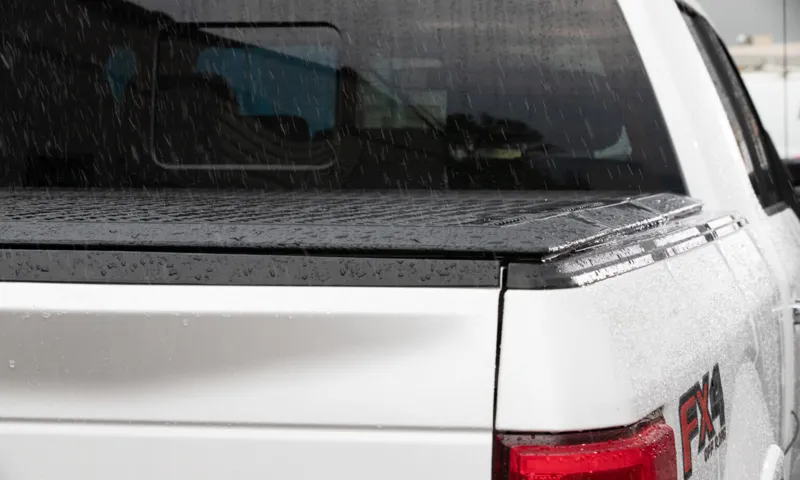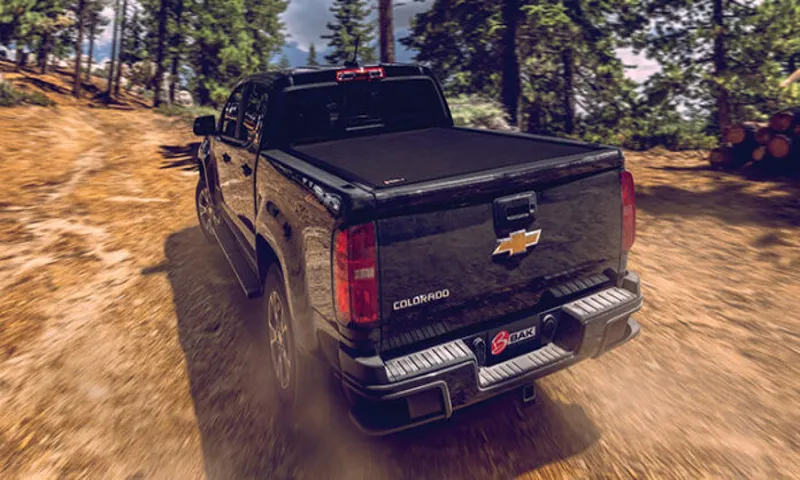So, you’ve got yourself a tonneau cover for your truck, and now you’re wondering how tight it should be. Well, you’ve come to the right place! Finding the perfect balance between too loose and too tight can be a bit tricky, but fear not, I’m here to help you out. When it comes to tonneau covers, a snug fit is essential.
You want it to be tight enough to keep out moisture and debris while driving, but not so tight that it becomes difficult to open and close. Think of it like a new pair of shoes – you don’t want them slipping off your feet, but you also don’t want them cutting off circulation. One way to check if your tonneau cover is tight enough is to give it a little tug.
If it moves more than an inch or so, it might be too loose. On the other hand, if it feels like you’re wrestling with it to get it closed, it’s probably too tight. A good rule of thumb is to make sure there is a slight amount of tension when closing the cover.
This will ensure a tight seal without putting too much stress on the cover or the mounting hardware. Remember, your tonneau cover should be a tool that makes your life easier, not a source of frustration. So, how exactly do you achieve the perfect level of tightness? Most tonneau covers come with adjustable tension control systems that allow you to tighten or loosen the cover as needed.
If you find that your cover is too loose, try tightening the tension control knobs or straps. If it’s too tight, simply loosen them up a bit. In conclusion, the tightness of your tonneau cover is all about finding that sweet spot.
It should be snug enough to keep out the elements but not so tight that it becomes a hassle to use. Remember to check the tension regularly and make adjustments as needed. With a little bit of trial and error, you’ll have your tonneau cover fitting just right in no time.
Table of Contents
Understanding the Purpose of a Tonneau Cover
When it comes to tonneau covers, getting the right level of tightness is crucial. A properly fitted tonneau cover not only looks great but also serves its purpose effectively. So, how tight should a tonneau cover be? Well, it should be snug but not overly tight.
If the cover is too loose, it may flap around while driving, causing unnecessary noise and potentially damaging the cover. On the other hand, if it’s too tight, it may put excessive strain on the cover and its components, leading to premature wear and tear. Finding the right balance is key.
Most tonneau covers come with adjustable tension settings that allow you to customize the tightness to suit your preferences. It’s important to follow the manufacturer’s recommendations and guidelines to ensure a proper fit. Remember, a well-fitted tonneau cover not only enhances the aesthetic appeal of your truck but also provides protection for your cargo from the elements while improving fuel efficiency by reducing drag.
Benefits of Using a Tonneau Cover
tonneau cover, benefits of using a tonneau cover, purpose of a tonneau cover. A tonneau cover is a must-have accessory for any truck owner. It serves multiple purposes and offers several benefits that can make a significant difference in your day-to-day life.
So, what exactly is the purpose of a tonneau cover? Well, it’s quite simple really. A tonneau cover is designed to protect the bed of your truck from the elements, such as rain, snow, and harmful UV rays. But that’s not all! It also provides added security by keeping your belongings out of sight and out of reach from prying eyes.
Additionally, a tonneau cover improves the aerodynamics of your truck, reducing drag and improving fuel efficiency. This means you’ll save money on gas in the long run. And let’s not forget about the aesthetic appeal.
A tonneau cover gives your truck a sleek and streamlined look that is sure to turn heads wherever you go. So, whether you use your truck for work or leisure, investing in a tonneau cover is a decision that you won’t regret.

Different Types of Tonneau Covers
tonneau cover, truck bed cover, types of tonneau covers, purpose of tonneau covers, truck accessories
Factors to Consider When Adjusting Tonneau Cover Tightness
tonneau cover tightness A tonneau cover is a popular accessory for pickup truck owners, as it provides protection and security for the bed of the truck. It is a high-quality cover that can be opened and closed, and its tightness plays a crucial role in its effectiveness. Understanding the purpose of a tonneau cover can help owners make the necessary adjustments to ensure proper tightness.
The primary purpose of a tonneau cover is to protect the cargo in the truck bed from the elements. Whether it’s rain, snow, or dust, a tight tonneau cover will prevent any damage or debris from reaching the cargo. Additionally, a tight cover can also enhance the security of the truck bed by keeping it hidden from potential thieves.
When adjusting the tightness of a tonneau cover, there are several factors to consider. First and foremost, it’s important to determine the intended use of the truck bed. If you frequently carry large or tall items, you may need to loosen the tonneau cover to accommodate the extra height.
On the other hand, if you primarily transport smaller items that require maximum protection, tightening the cover will ensure a secure fit. Another factor to consider is the type of tonneau cover you have. Different covers have different mechanisms for adjusting tightness, such as latches, straps, or tension adjusters.
It’s important to familiarize yourself with the specific instructions for your tonneau cover to make the necessary adjustments correctly. Lastly, weather conditions should also be taken into account when adjusting tonneau cover tightness. In hot climates, the tonneau cover may expand, making it necessary to loosen the cover slightly to prevent damage.
Conversely, in cold climates, the cover may contract, requiring tighter adjustments to maintain a secure fit. By considering these factors and making the necessary adjustments, you can ensure that your tonneau cover is both functional and effective. Whether you’re protecting your cargo from the elements or securing your truck bed, proper tonneau cover tightness is essential for optimal performance.
Determining the Proper Tightness for Your Tonneau Cover
Have you ever wondered how tight your tonneau cover should be? Well, the answer to that question depends on a few factors. First, you’ll want to consider the type of tonneau cover you have. Some covers are designed to be tightened down snugly, while others allow for a looser fit.
Next, you’ll want to think about the weather conditions you typically encounter. If you frequently drive in heavy rain or snow, you’ll want to ensure your tonneau cover is tight enough to keep out any moisture. On the other hand, if you primarily drive in dry conditions, you may be able to get away with a slightly looser fit.
Another factor to consider is the type of cargo you typically carry in your truck bed. If you often transport delicate or valuable items, you’ll want to make sure your tonneau cover is tightened down securely to protect them. However, if you typically transport larger, bulkier items, a looser fit may be sufficient.
Ultimately, the proper tightness for your tonneau cover is a personal preference. It’s important to find a balance between a snug fit that keeps out the elements and a flexible fit that allows for easy access to your truck bed. Take the time to adjust your cover to your desired tightness and regularly check for any signs of wear or damage.
By doing so, you’ll ensure that your tonneau cover is not only tight enough but also in good condition for years to come.
Manufacturer’s Recommendations
tonneau cover, tightness, manufacturer’s recommendations, determining the proper tightness When it comes to installing a tonneau cover on your truck, it’s important to make sure you get the proper tightness. Not only does this ensure the cover will stay in place, but it also helps to protect your cargo from the elements. So how do you determine the right amount of tightness? Well, the best place to start is by checking the manufacturer’s recommendations.
Each tonneau cover is different, so it’s important to follow the specific guidelines provided by the manufacturer. These recommendations will typically include information on things like the recommended amount of tension and the proper way to secure the cover to your truck bed. By following these guidelines, you can ensure that your tonneau cover is properly installed and will provide the protection you need.
So before you start tightening down your tonneau cover, take a few minutes to familiarize yourself with the manufacturer’s recommendations. You’ll be glad you did.
Visual Appearance
Determining the proper tightness for your tonneau cover is an important step in preserving its visual appearance. When it comes to tonneau covers, finding the right balance between tightness and flexibility is key. If the cover is too tight, it can put unnecessary strain on the material and lead to wear and tear.
On the other hand, if it’s too loose, it can create flapping and allow water and debris to get inside. To find the perfect tightness, start by positioning the cover according to the manufacturer’s instructions. Then, slowly tighten the cover to ensure a snug fit without overstretching the material.
Keep in mind that different tonneau covers have different tightening mechanisms, such as snaps, buckles, or straps. Take your time and adjust the tightness as needed until you achieve the perfect balance. Remember, a properly tightened tonneau cover not only looks better but also performs better in terms of protecting your cargo from the elements.
Functionality
tonneau cover tightness, tonneau cover functionality, proper tonneau cover tightness, determining tonneau cover tightness
Weather Resistance
One important factor to consider when choosing a tonneau cover for your truck is its weather resistance. A tonneau cover that isn’t properly sealed can allow water to seep in, ultimately causing damage to the contents in your truck bed. So how do you determine the proper tightness for your tonneau cover to ensure optimal weather resistance? One method is to follow the manufacturer’s instructions for installation and tightening.
These instructions typically provide step-by-step guidance on how to properly secure the cover to your truck bed. Another method is to visually inspect the cover after installation. Look for any gaps or areas where the cover isn’t snug against the bed of your truck.
If you spot any issues, you may need to adjust the tension or position of the cover to create a tighter seal. Remember, the goal is for the cover to fit securely in order to keep out rain, snow, and other elements. A tightly sealed tonneau cover will provide the best protection for your truck bed, ensuring that your valuables stay dry and protected, no matter the weather.
Adjusting the Tightness of Your Tonneau Cover
Ensuring the right tightness for your tonneau cover is important to maintain its effectiveness and protect your cargo from the elements. But how tight should a tonneau cover be? Well, the answer can depend on a few factors. Firstly, it’s important to consider the specifics of your truck model and the type of tonneau cover you have.
Some covers may have specific instructions or recommended tightness settings provided by the manufacturer. Additionally, you can consider how secure you want your cover to be. A tighter fit can provide better protection against rain, dirt, and wind, but it may make it more difficult to open and close the tonneau cover.
On the other hand, a looser fit may be more convenient for easy access to your truck bed, but it may not provide as much security for your cargo. It’s also worth noting that factors like temperature and weather conditions can affect the tightness of your tonneau cover. In colder temperatures, the cover may contract and become tighter, while in hot temperatures, it may expand and become looser.
Ultimately, finding the right tightness for your tonneau cover might involve some trial and error to strike the perfect balance between security and convenience for your specific needs.
Step-by-Step Guide to Adjusting Tightness
adjusting tightness, tonneau cover, step-by-step guide, adjust tightness, tonneau cover Are you having trouble with the tightness of your tonneau cover? Whether it’s too loose or too tight, finding the right balance can be a challenge. But don’t worry, we’ve got you covered! In this step-by-step guide, we’ll walk you through the process of adjusting the tightness of your tonneau cover, so you can enjoy a properly fitting and secure cover for your truck bed. First, let’s start with the basics.
Your tonneau cover is designed to protect your truck bed from the elements and keep your cargo secure. It should fit snugly and be securely fastened to prevent any movement or water from getting in. If your tonneau cover is too loose, it can flap in the wind and potentially damage your truck bed.
On the other hand, if it’s too tight, it can be difficult to open or close, and it may not provide adequate protection. To adjust the tightness of your tonneau cover, begin by identifying the type of closure system it uses. Some covers have a latch system, while others use Velcro or snap fasteners.
Once you know the type of closure system, you can proceed with the adjustments. If your tonneau cover uses latches, start by loosening the latches on both sides of the cover. Then, gradually tighten them until you achieve the desired tightness.
Be sure not to overtighten, as this can cause damage to the latches or the cover itself. It’s important to find the sweet spot where the cover is secure but still easy to open and close. For tonneau covers with Velcro or snap fasteners, the process is slightly different.
Begin by inspecting the fasteners for any signs of wear or damage. If they are worn out, it may be time to replace them. If they are in good condition, start by loosening the fasteners and then gradually tighten them until the cover is snug.
Tips and Tricks for Achieving the Right Tightness
If you have a tonneau cover for your truck, you know how important it is to achieve the right tightness. A properly tightened tonneau cover not only keeps your cargo protected from the elements but also improves the overall look of your vehicle. So how can you adjust the tightness of your tonneau cover? Well, it’s actually quite simple.
Most tonneau covers come with adjustable tension control knobs or straps that allow you to tighten or loosen the cover as needed. By turning the knob or pulling on the straps, you can easily customize the tightness to your liking. It’s important to find the right balance – not too tight that it strains the cover or too loose that it flaps in the wind.
Take the time to experiment with different adjustments until you find the perfect fit. Remember, a properly tightened tonneau cover is essential for ensuring the security and protection of your cargo while adding a sleek and polished look to your truck.
Common Mistakes to Avoid
When it comes to installing a tonneau cover on your truck bed, one common mistake that many people make is not tightening it enough. But just how tight should a tonneau cover be? Well, the answer to that question depends on the type of tonneau cover you have. If you have a soft roll-up cover, it should be tight enough to prevent any sagging or flapping in the wind.
You want it to be snug, but not so tight that it puts unnecessary strain on the cover or the truck bed. A good rule of thumb is to tighten it enough that you can’t easily slide your hand underneath, but not so tight that it feels like it’s going to rip. On the other hand, if you have a hard folding or retractable cover, it should fit securely and evenly across the entire truck bed.
You want to make sure that there are no gaps or spaces where water or debris can get in. Again, you want it to be tight, but not so tight that it puts unnecessary strain on the cover. In summary, when it comes to how tight a tonneau cover should be, the key is to find a balance.
You want it to be snug enough to prevent any sagging or flapping, but not so tight that it causes damage. So take your time during the installation process and make sure to adjust the tension as needed to find that perfect fit.
Over-Tightening the Tonneau Cover
tonneau cover, over-tightening, common mistakes to avoid When it comes to installing a tonneau cover on your truck bed, it’s important to get the tension just right. Many people make the mistake of over-tightening the cover, thinking that the tighter it is, the better it will stay in place. However, over-tightening can actually cause more harm than good.
One of the main issues with over-tightening is that it can put excessive stress on the cover and the mounting hardware, potentially leading to damage or even a complete failure of the cover. Additionally, over-tightening can cause the cover to pull too tightly across the truck bed, which can lead to wrinkling and distortion of the cover material. This not only looks unsightly, but it can also make it difficult to close and secure the cover properly.
Furthermore, over-tightening can put unnecessary strain on the clamps or latches that are used to secure the cover. This can result in them becoming loose or even breaking, which can compromise the overall security of the tonneau cover. So, what’s the optimal tension for a tonneau cover? It’s important to follow the manufacturer’s instructions and recommendations for your specific cover.
Generally, you want the cover to be tight enough to prevent any flapping or movement while driving, but not so tight that it causes any of the issues mentioned above. In conclusion, over-tightening a tonneau cover is a common mistake that should be avoided. It can lead to damage to the cover, distortion of the material, and compromised security.
By following the manufacturer’s instructions and finding the right balance of tension, you can ensure that your tonneau cover performs optimally and lasts for years to come.
Under-Tightening the Tonneau Cover
tonneau cover installation, under-tightening, common mistakes, avoid Installing a tonneau cover on your truck bed is a great way to protect your cargo from the elements and keep it secure. However, there are common mistakes that people make when installing their tonneau covers, and under-tightening is one of them. Under-tightening the tonneau cover can lead to a range of issues, such as water leakage, wind resistance, and potential damage to the cover itself.
Imagine driving down the highway and seeing your tonneau cover flapping in the wind like a sail. Not only does it look unsightly, but it can also damage the cover and reduce its lifespan. To avoid this issue, it’s essential to follow the manufacturer’s instructions and ensure that the cover is tightened properly.
This may involve using a torque wrench or other tools to achieve the correct tension. Remember, a properly tightened tonneau cover will provide maximum protection for your cargo and keep your truck looking its best. So, don’t underestimate the importance of getting it right and avoid the common mistake of under-tightening your tonneau cover.
Conclusion
In the world of tonneau covers, there is a delicate balance between tightness and looseness. You see, a tonneau cover can’t be too tight, for then it would resemble a vacuum-sealed prison, suffocating your precious cargo beneath it. Conversely, it can’t be too loose either, as that would defeat the purpose of having a cover in the first place.
So, how tight should a tonneau cover be, you ask? Well, picture Goldilocks trying to find the perfect porridge – not too hot, not too cold, but just right. Similarly, a tonneau cover should be snug enough to keep out the pesky elements, like raindrops trying to crash your cargo’s party. Yet, it should have enough give to allow for expansion and contraction, like a yogi stretching after a long nap.
Think of it as a gentle embrace from your tonneau cover, a reassuring hug to your precious payload. Not too tight that it restricts movement, but not too loose that it flaps in the wind like a flag on a stormy day. The ideal tightness of a tonneau cover is like finding the perfect level of spice in your favorite recipe.
It enhances the flavor and keeps everything in place, without overpowering the main ingredients. It’s a delicate dance, a tightrope act that only a true tonneau cover master can achieve. So, remember, my friends, when it comes to tonneau covers, don’t settle for anything less than perfection.
Find that sweet spot of tightness that makes your cargo feel safe and snug, all the while adding a touch of style to your truck. And with the right tonneau cover, you’ll be hitting the road, knowing that your cargo is protected, your truck is looking sharp, and you’ve achieved the perfect balance between tight and just right.”
FAQs
How tight should a tonneau cover be?
A tonneau cover should be tight enough to prevent any flapping or movement while driving, but not so tight that it puts excessive strain on the cover or the vehicle’s bed.
Can a tonneau cover be too tight?
Yes, a tonneau cover can be too tight. If it is overly stretched or pulled tightly, it may cause damage to the cover or the truck bed.
What are the risks of having a tonneau cover that is too tight?
Having a tonneau cover that is too tight can potentially lead to tears or rips in the cover material, and it may also put stress on the attachment points or hinges of the cover.
How can I determine the right tightness for my tonneau cover?
To determine the right tightness for your tonneau cover, you can refer to the manufacturer’s instructions or guidelines. Generally, the cover should be taut enough to prevent flapping or movement, but it should also allow for some flexibility.
Will a loose tonneau cover affect its performance?
Yes, a loose tonneau cover can affect its performance. It may allow water, dust, or debris to enter the truck bed, defeating the purpose of having a cover. It may also cause flapping or noise while driving.
Can weather conditions affect the tightness of a tonneau cover?
Yes, weather conditions can affect the tightness of a tonneau cover. Extreme temperatures can cause the cover material to expand or contract, which may result in changes in tightness. It is recommended to periodically check the tightness and make adjustments if needed.
Are there any adjustments I can make to tighten a loose tonneau cover?
Yes, there are adjustments you can make to tighten a loose tonneau cover. This can include tightening or adjusting the attachment points, using tensioning devices or clamps, or applying adhesive weatherstripping to seal any gaps or looseness. It is important to follow the manufacturer’s instructions when making adjustments.



